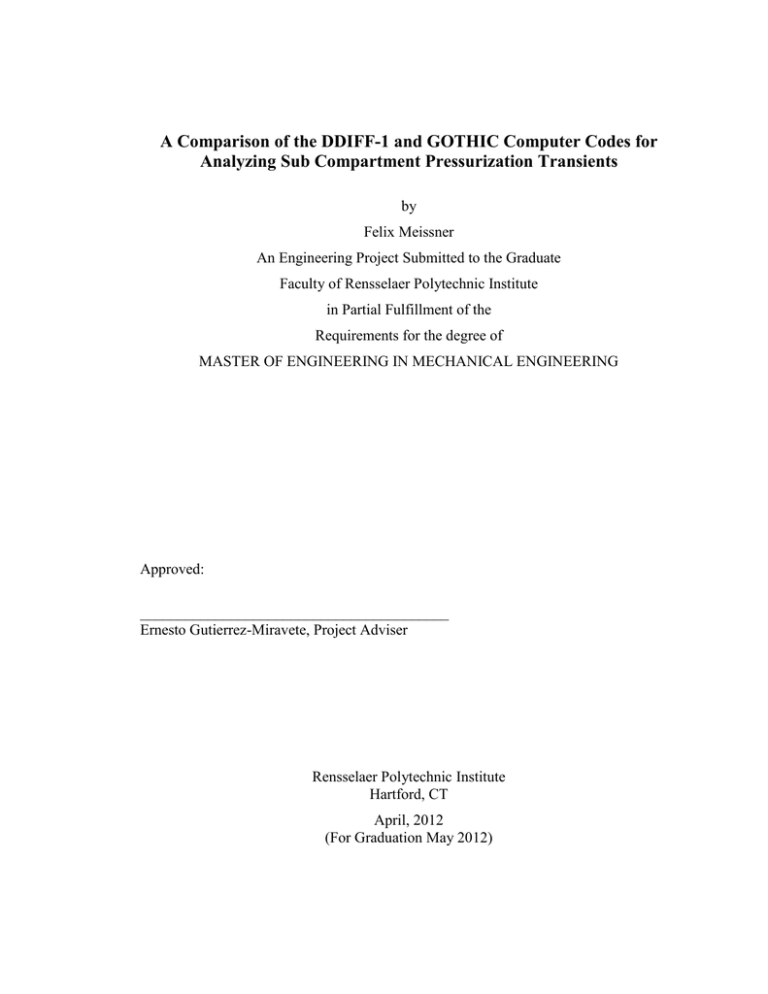
A Comparison of the DDIFF-1 and GOTHIC Computer Codes for
Analyzing Sub Compartment Pressurization Transients
by
Felix Meissner
An Engineering Project Submitted to the Graduate
Faculty of Rensselaer Polytechnic Institute
in Partial Fulfillment of the
Requirements for the degree of
MASTER OF ENGINEERING IN MECHANICAL ENGINEERING
Approved:
_________________________________________
Ernesto Gutierrez-Miravete, Project Adviser
Rensselaer Polytechnic Institute
Hartford, CT
April, 2012
(For Graduation May 2012)
© Copyright 2012
by
Felix Meissner
All Rights Reserved
ii
CONTENTS
LIST OF FIGURES .......................................................................................................... iv
GLOSSARY ...................................................................................................................... v
ACKNOWLEDGMENT .................................................................................................. vi
ABSTRACT .................................................................................................................... vii
1. Introduction.................................................................................................................. 1
1.1
Problem Statement ............................................................................................. 2
2. Code Methodologies .................................................................................................... 3
2.1
DDIFF-1 Methodology ...................................................................................... 3
2.2
GOTHIC Methodology ...................................................................................... 6
3. Model Setup ............................................................................................................... 10
3.1
SGSC Model .................................................................................................... 10
3.2
DDIFF-1 Model ............................................................................................... 12
3.3
GOTHIC Model ............................................................................................... 12
4. Results........................................................................................................................ 15
4.1
DDIFF-1 Noise Reduction ............................................................................... 15
4.2
Comparison of Results ..................................................................................... 15
5. Conclusions and Recommendations .......................................................................... 21
REFERENCES ................................................................................................................ 22
iii
LIST OF FIGURES
Figure 1: Typical PWR Containment Rector Building……………………………...……. 1
Figure 2: Typical DDIFF-1 Input Deck…………………………………………………... 5
Figure 3: Typical DDIFF-1 Output Deck………………………………………………… 6
Figure 4: ………………………………………………………….
9
Figure 5: Cross Section of the Analyzed SGSC………………………………………… 11
Figure 6: General Outline of a SG………………………………………………………..12
Figure 7: GOTHIC Model Diagram…………………………………………………...... 14
Figure 8: Maximum Pressure Difference Across the SG in Level 1……………………. 17
Figure 9: Maximum Pressure Difference Across the SG in Level 2……………………. 18
Figure 10: Maximum Pressure Difference Across the SG in Level 3…………………... 18
Figure 11: Maximum Pressure Difference Across the SG in Level 4…………………... 19
Figure 12: Maximum Pressure Difference Across the SG in Level 5…………………... 19
Figure 13: Maximum Pressure Difference Across the SG in Level 6…………………... 20
iv
GLOSSARY
BWR - boiling water reactor
CAD - computer aided design
CFD - computational fluid dynamics
EPRI - Electric Power Research Institute
GOTHIC - Generation of Thermal-Hydraulic Information for Containments
GUI - graphical users interface
NAI - Numerical Applications Inc.
NRC - Nuclear Regulatory Commission
PWR - pressurized water reactor
RCS - reactor coolant system
RV - reactor vessel
RVSC - reactor vessel sub-compartment
SC - sub-compartment
SG - steam generator
SGSC - steam generator sub-compartment
v
ACKNOWLEDGMENT
I’d like to acknowledge and thank my advisor, Ernesto Gutierrez-Miravete, for providing
direction and guidance during this project and my master’s degree. I’d also like to
acknowledge and thank the other RPI faculty, colleagues, friends and family; all of who
provided tremendous support and assistance which was essential for the successful
completion of my degree.
vi
ABSTRACT
This paper successfully benchmarks the GOTHIC computer code to the DDIFF-1
computer code and recommends replacement of DDIFF-1 with GOTHIC. Transient
response of a SGSC following a feedwater pipe break was analyzed with both codes.
The main result of interest, pressure differences across the SG, was calculated and found
to be comparable.
DDIFF-1 is an old code (written in the 1960s) using elementary solution techniques and
input methods (no GUI). GOTHIC, developed by NAI, is a modern, industry
standardized, and accepted computer code that uses sophisticated solution methods with
increased precision and accuracy. Faster computing speed combined with a GUI makes
the standard GOTHIC code a better tool for SC analyses.
vii
1. Introduction
In the unlikely event that a high energy piping system ruptures (either a main or tributary
line break) inside a sub-compartment (SC) in the reactor containment building of a
pressurized water reactor (PWR, see Figure 1 for a typical example), asymmetric
pressurization (local pressure differences) may occur around components or walls,
resulting in loads that could damage structures within the SC. Typically these
pressurization transients only last on the order of seconds.
Figure 1: Typical PWR Containment Rector Building
The Nuclear Regulatory Commission (NRC) has stringent guidelines on accident
management and analysis. It ranks postulated scenarios according to severity and
dictates that a postulated accident cannot lead to a higher order accident. For example, a
feedwater line break inside the steam generator (SG, component #8 in Figure 1) SC
cannot lead to a failure of the SG which would breach the reactor coolant system (RCS)
boundary. Or in other words, a small pipe break cannot lead to the failure of a huge
component. Therefore, pressurization of the steam generator sub-compartment (SGSC,
and the resulting loads on the components within the SC) must be analyzed to
demonstrate that the NRC guidelines on accident management are adequately met.
1
DDIFF-1 [1] is designed to analyze the asymmetric pressurization of reactor
containment building SCs, either a SGSC or a reactor vessel sub-compartment (RVSC).
DDIFF-1 is based on the original DDIFF code which was developed by Kraftwerk
Union of the Federal Republic of Germany. Once calculated, the pressure time histories
of all the nodes in the SC are forwarded to a structural group, which uses them to
determine the loadings on the components of interest.
GOTHIC [2] is a modern computer code developed by Numerical Applications Inc.
(NAI) for transient thermal hydraulic analyses of multiphase systems in complex
geometries. The latest version (version 8) was just released. GOTHIC was developed for
the nuclear industry, specifically to analyze reactor containment buildings. References
[3] and [4] document research using the GOTHIC code for reactor containment building
analyses.
This paper investigates the feasibility of replacing the DDIFF-1 code with GOTHIC for
SC asymmetric pressurization transient analyses. The investigation process is completed
in two steps; first gain more insight into each code by studying the methodology and
solution methods, second perform a benchmark analysis of a GOTCHIC SGSC model to
a similar DDIFF-1 model. Compare the results and determine the feasibility of using the
GOTHIC computer code for applications which DDIFF-1 has been the historical
solution vehicle choice.
1.1 Problem Statement
The DDIFF-1 code was written in FORTRAN code in the 1960s. It is an old code that
uses basic correlations and approximation schemes. Working with DDIFF-1 is not easy;
it does not have a graphical users interface (GUI); inputs are provided via an input deck
and outputs are reported in a similar fashion. Resources familiar with and able to debug
older programs are becoming harder to find. DDIFF-1 needs to be replaced by a more
modern code.
2
2. Code Methodologies
2.1 DDIFF-1 Methodology
DDIFF-1 is a code which was specifically written to calculate the transient response of a
SC in the unlikely event of a loss-of fluid incident in a high energy fluid system. The
DDIFF-1 computer code is primarily used to predict SC conditions for the first few
seconds following incident initiation during which the maximum pressure differentials
on structures or components would occur. The transient calculations include
determination of mass flow rates, mass and energy inventories, absolute and differential
pressures, and temperatures in the SC system. The SC system is a control volume-flow
path network created based upon the geometry of the SC being analyzed. Blowdown
mass and energy release rates from the postulated pipe rupture are determined by an
independent computer program and these histories are input to DDIFF-1. The output of
interest is the differential (asymmetric) pressurization of the SC, as this will induce
dynamic loads on components within the SC. The calculated pressurization history is
used as input in a downstream structural analysis which will transform the differential
pressures into stresses on the components.
Methodology employed by DDIFF-1 is documented in Reference [1]. DDIFF-1 solves
the mass, momentum and energy balance equations, as well as the equation of state for
each control volume (or node) assuming lumped parameters. Inertia terms are included
in the momentum balance equations. Homogenous equilibrium two phase flow
correlations and Moody’s critical flow models are used to determine the flow between
the control volumes. Numerical computations are performed using a simple forward
integration method in a finite difference scheme. Time steps are specified in the input
and can be dependent on time in transient, but are not dynamic based on the quality of
the computations. Homogeneity and equilibrium are assumed for each control volume,
therefore each component (state) occupies the entire control volume and temperatures
for these components are equal within the control volume (node).
In Reference [1], results predicted by DDIFF-1 are benchmarked to test results. DDIFF1 over predicts the initial pressure spike following blowdown (especially in the “break
room”, the control volume where blowdown is introduced). This over-prediction results
3
in conservative loadings on the components calculated by the downstream structural
group.
For setting up the control volumes, node volume is the only input needed. For setting up
the flow paths, flow area, inertia length, geometric loss coefficient and frictional loss
coefficients and elevation differences are needed. These inputs must be user calculated
with information from drawings. With all the components within the SC, it is time
consuming and difficult to accurately calculate the nodal interface and flow areas.
Inputs are specified via a user generated input deck (typical example shown in Figure 2).
The structure of this input deck is based on the card system employed by early
FORTRAN codes. Outputs are provided in a similar fashion (Figure 3), via output decks
that must be post processed using Excel or a similar data manipulation program.
Performing a full SGSC analysis using the DDIFF-1 code involves gathering and
calculating the required inputs, setting up the physical model, applying the boundary
conditions, running the model and analyzing the results. It takes about 400 man-hours to
conduct a typical SC analysis using DDIFF-1.
4
Figure 2: Typical DDIFF-1 Input Deck
5
Figure 3: Typical DDIFF-1 Output Deck
2.2 GOTHIC Methodology
The GOTHIC thermal-hydraulics computer code, described in Reference [2] is
becoming the industry standard for performing containment analyses, as well as analyses
for auxiliary buildings outside containment. The code was been developed by NAI with
funding by the electric power research institute (EPRI). GOTHIC has been reviewed and
approved by the NRC for containment analysis applications for several U.S. utilities.
GOTHIC was specifically designed for use in design, licensing, safety and operating
analysis of nuclear power plant containments and SCs. The prime application of
GOTHIC is the evaluation of containment and containment SC response after a high
energy line break.
GOTHIC solves the mass, momentum and energy balance equations, as well as the
equation of state for multi-phase and multi-component flow. Models for mass, energy
6
and momentum transfer at the interfaces between phases and components span from
single phase flow to complex boiling. Interface models make it possible for GOTHIC to
analyze non thermal equilibrium states between phases and unequal phase velocities.
This is one major advantage of GOTHIC over DDIFF-1, the ability to more accurately
predict phase interactions and analyze non-thermal equilibrium between different
components within a control volume.
Phases that GOTHIC can model and analyze include gas, liquid, droplet and mist. The
gas phase includes water steam and various (up to 8) non-condensing gases. Inertia
terms
are
included
in
the
momentum
balance
equations,
applied
in
the
junctions/flowpaths that connect nodes.
GOTHIC transient results have been successfully compared with results from other
containment analysis codes (COCO, CONTEMPT, CONRANS, CONTAIN and
COPATTA). Differences between the GOTHIC results and the results from other codes
are attributed to the ability of GOTHIC to better model droplet phase interface heat and
mass transfer.
GOTHIC can perform its calculations using two different methods, in either a lumped
parameter (similar to DDIFF-1) or domain model. By using the domain model, basic
computational fluid dynamics (CFD) capabilities are introduced into the model. Nodes
can be subdivided by simply drawing x, y and z grid lines. Subdividing a node is similar
to meshing a domain/model in a conventional CFD program. In GOTHIC however, this
meshing/subdividing is limited to rectangular schemes (unlike more complex geometry
which is available in conventional CFD programs) and must be drawn via continuous
grid lines. The GOTHIC terminology will be used throughout this paper. A node is a
control volume with the lumped parameter model applied; a subdivided node is a domain
that is “meshed” into individual cells. Using the subdivided method considers each cell
as an individual control volume.
Blockages of different geometric shapes can be used in a subdivided node to “carve-out”
the geometric shape of the model. Coordinates and dimensions of these blockages are
specified so that they can be placed appropriately. Internal blockages represent volume
where there is no fluid flow and are also used to model the components within the SC.
For instance, pump motors (which are located within the analyzed SGSC) can be
7
approximated as rectangular prisms. In order to model that flow blockage in GOTHIC, a
rectangular prism blockage is placed at the coordinates of the pump motors. In a
subdivided scheme, ends of flowpaths are placed into an explicit cell and the orientation
of each flowpath is specified. A SC can be modeled as one subdivided node by making
use of blockages to model the components within the SC.
When using a subdivided node model, GOTHIC automatically determines the interface
areas and flow information between cells. Blockages are included in this determination.
This eliminates the manual and time intensive flow path parameter calculations that are
needed when setting up a DDIFF-1 model, saving time and effort in the development of
the SC model. Numerical computations within subdivided nodes are performed using
bounded second order upwind methods in a finite volume scheme.
For large and complex problems, Gauss-Seidel, conjugate gradient and multigrid
iterative techniques are also available in GOTHIC. Time steps are automatically
calculated and adjusted so that the solution remains stable, however minimum and
maximum values must be specified in the input.
Inputs are specified via an interactive GUI (Figure 4). This screenshot shows a typical
GUI used in the process of subdividing (meshing) the SGSC using the gridlines. On the
right hand side is a graphic of the modeled SC with the blockages in place. The gray
triangles at the top form the trapezoidal shape of the SC, the circles represent the SG and
the pumps within the SC. Note that the pressurizer is not shown in this view. In the
center is a dialog box used for specifying the inputs, in the upper left is a table showing
the actual inputs that will be used.
Outputs are available in graph form, as well as user specified data files. Only the data
files will be used for this analysis, as some data manipulation/post-processing will be
done in Excel for convenience. Performing a full SGSC analysis using the GOTHIC
code anywhere between 100 to 200 man-hours (25-50% of the time it takes to complete
a similar DDIFF-1 analysis). This time saving is due to the ability of GOTHIC to
automatically calculate the parameters for flow inside the SC (by using a subdivided
node), which has to be done manually for the DIFF-1 model.
8
Figure 4: This typical GOTHIC GUI screenshot shows the process of subdividing (meshing) the SGSC in the vertical direction via gridlines. The table
in the upper left hand corner displays the selected gridlines. The table near the center of the screen is used to specify the inputs. The figure at the right
of the screen shows the model with the blockages (gray) in place.
9
3. Model Setup
3.1 SGSC Model
The analyzed SGSC in a PWR (Figure 5) has the shape of a trapezoidal prism (about 60
feet by 30 feet and 80 feet high) and is located within containment right next to the
RVSC. Major components within the SGSC are a pressurizer, two pumps and the SG
(Figure 6). The pressurizer is a large cylinder with dome ends, approximately 35 feet
high with a diameter of 10 feet. Its function is to ensure the RCS (not shown) remains in
a sub-cooled state. Water within the pressurizer is kept at saturation at the desired RCS
pressure. A small surge pipe connects the pressurizer to the RCS and this ensures that
the coolant within the RCS remains at the right pressure and does not boil (like in a
boiling water reactor (BWR)). The pumps within the SGSC are the large coolant pumps
(diameter of about 6 feet). They each move about 100,000 gpm of coolant which
transfers the thermal energy form the reactor to the SG. The SG is a U-tube heat
exchanger which removes heat from the coolant and transfers it to the secondary side.
Secondary side water in the SG is at a lower pressure (less than half of RCS pressure)
and gets boiled. The resulting steam is piped through the turbine which turns the
generators.
A feedwater pipe (approximately 1 foot diameter) supplies the SG with “cold” water. Its
nozzle is located near the top of the SG. A break of the feedwater pipe at this nozzle will
be analyzed. Such a pipe break would allow the SG (initially at saturated conditions,
pressure of around 1000 psi) and the feedwater pipe to blow down into the SGSC. In the
analyzed SGSC nodal model, the SG nozzle is located in the fifth (out of seven) vertical
level, split into the north-west and north-east (of the SG) nodes.
At the time when the postulated pipe break occurs, the north side of the SGSC
pressurizes quicker than the south side, resulting in differential pressure and loads on the
SG. Initially the differential pressure spikes as the inertia of the stagnant air in the SC is
overcome and then it settles to a quasi steady-state value. This initial pressurization
(magnitude of and time) is of interest to the downstream structural analyses. During the
short duration of the transient (on the order of seconds), level changes in the feedwater
10
pipe and SG will not impact the blowdown, so the mass and energy release into the SC is
assumed constant.
Figure 5: Cross Section of the Analyzed SGSC
11
Figure 6: General Outline of a SG
3.2 DDIFF-1 Model
The DDIFF-1 model for the SGSC being analyzed has 65 nodes (64 for the SGSC plus 1
for containment), arranged in 7 equally spaced vertical levels. In each of the bottom 4
levels, there are 12 nodes, 4 for each pump area and 4 for the SG area. In levels 5
through 6 (above the pumps but still within the SC walls) there are 6 nodes per level, 4
for the SG area and 1 per pump area. The SC walls housing the pumps do not reach the
7th level and only 4 nodes for the SG area are needed. Node volume is the only major
input needed.
Nodal connections and interfaces are modeled with flowpaths. Required information for
the flowpaths include: flow area, inertia length, geometric loss coefficient, frictional loss
coefficient, and elevation difference.
Nodal and flowpath information is typically obtained from a customer provided
computer aided design (CAD) model of the SGSC. The model is imported into ANSYS,
inversed, stripped of all minor components (like ladders, stairs etc.) and divided into
nodes. An ANSYS -routine is written to output nodal volume and to calculate the
required information to model the flowpaths. Mass and energy blowdown is input by
release rate and node number. The time interval for calculations is specified as 0.00005
seconds.
3.3 GOTHIC Model
The GOTHIC model consists of 2 nodes, 1 subdivided node (consisting of 84 cells) to
model the SGSC and 1 node for the containment which contacts the top of the SGSC.
The SGSC node is subdivided into 7 vertical layers (levels), each having 12 cells (4 in
each pump area and 4 in the SG area, for a total of 84 cells). The levels are numbered
consecutively with elevation, with level 1 being the bottom level. Blockages are used to
shape the trapezoidal shape of the SGSC and to account for the pumps, SG, pressurizer,
walls between the SG and pump areas of the SC at the higher elevations and various
piping near the bottom of the SC. Blockages are also used to cap the height of the pump
areas of the SC, as that portion of the SC does not extend as high as the SG portion of
12
the SC. Twelve flowpaths model the openings at the top of the SGSC to containment.
They connect each subdivided node at the top of the SGSC to the containment node.
Mass and energy blowdown is introduced into the model via flow boundary conditions,
and connected to the appropriate subdivided node via flowpaths. A diagram of the nodes,
boundary conditions and flowpaths is shown in Figure 7. The dashed-line boxes (labeled
1 and 2s) are the atmospheric (lumped parameter) and SC (subdivided into cells) nodes.
The solid line boxes (labeled 1F and 2F) are the flow boundary conditions which add the
mass and energy blowdown into the model. The blowdown is transferred into the SC
node via flowpaths #1 and #2 (solid lines). The remaining flowpaths (solid lines #3 #14) connect the cells at the top of the SC to the atmosphere node (1).
Input information consists of dimensions of the SGSC and of all the components within
the SC. This is obtained from plant drawings and was confirmed to match the
information used in the DDIFF-1 model. GOTHIC is able to dynamically adapt the time
step size based on the accuracy of the computation (by analyzing the computational
residuals). Time step intervals are limited to be between 1E-10 and 1E-05 seconds for
this SC model. GOTHIC was able to successfully calculate the solution using the
maximum time step interval (i.e. the residuals remained below the threshold even with
the maximum specified time step interval).
By using the blockages feature to create a SGSC model in GOTHIC, it makes the
process much easier and more effective than manually dividing the SGSC into nodes and
calculating the info for the interfacing flowpaths. This is a major reason for the reduced
time required for a GOTHIC analysis.
13
Figure 7: GOTHIC Model Diagram
14
4. Results
4.1 DDIFF-1 Noise Reduction
The output data obtained from DDIFF-1 reports pressures for each node at 227 different
time steps during the relatively short transient (on the order of seconds). These data
points contain a lot of noise, due to the simplistic schemes employed by DDIFF-1 and
make data comparisons impossible. In order to better compare the DDIFF-1 results to
those obtained by GOTHIC; noise was filtered out by averaging every 5 consecutive
data points. Without this noise reduction routine, it would be impossible to make a
deterministic comparison between the results of the two codes.
4.2 Comparison of Results
The most heavily loaded (and most critical) component during a SGSC transient is the
SG. Therefore, the most important result of a SGSC analysis is the pressure difference
and loading across the SG. Pressure differentials across the pump and pressurizer are of
secondary importance. Since the break is located near the SG, a comparison of the peak
pressures across the SG at each level is a good method to compare the two codes.
Maximum pressure differences predicted by each code across the SG (maximum of the
absolute value of either the north-east minus south-west or north-west minus south-east
nodes) at each time step and level in the vertical direction were calculated. Results were
normalized to the maximum pressure differential (from all levels, on the order of tens of
psi) and to the time in transient. Comparisons between the results obtained from each
code are plotted and shown in Figure 8 through Figure 13 for the first 6 levels of the SC.
Results from GOTHIC are somewhat noisy (especially in the lower levels), but dampen
to more consistent values and have lower amplitude low-frequency noise than those
from DDIFF-1, even after the noise reduction scheme was applied to the DDIFF-1
results. This is expected, since GOTHIC uses a second order upwind solution method,
which is more numerically stable than the forward integration method used by DDIFF-1.
The feedwater pipe (analyzed break location) is located in the fifth vertical level.
Pressure differentials in levels 4 and above are the most important; since they exert
forces on the SG at a higher elevation, they cause the highest momentum and stress on
15
the SG. Since blowdown is introduced on level 5, they also have the highest pressure
differential.
As expected (and described in Section 2.1), DDIFF-1 over-predicts the initial pressure
spike in the break room on level 5 (shown in Figure 12). Initially, the DDIFF-1 pressure
differential reaches its transient peak and then dampens down to about 20%, whereas the
GOTHIC result spikes to 35% and then dampens down to about 20%. Examining the
DDIFF-1 initial pressure spike over-prediction data documented on Reference [1], the
GOTHIC predicted peak of 35% is much closer to the test data and is as expected. Level
6 (directly above level 5) connects to level 7, which vents to the atmosphere. Pressure
differentials for level 6 are shown in Figure 13. Despite the DDIFF-1 over-predicted
pressure spike in level 5, for level 6, the GOTHIC and DDIFF-1 values are very
comparable, both in oscillation shapes and magnitude.
Level 4 pressure differentials predicted by DDIFF-1 (Figure 11) are affected by the overpredicted initial pressure spike in level 5, peaking at 26% versus 10% and then
dampening down to about 2%. The pressure differentials are very similar (both in
magnitude and shape) at the most important elevations (levels 4 and above). For
conservatism, only the top openings/vents in the SGSC were modeled. This leads to
greater numerical oscillations in levels 4 and below, as the blowdown gets pushed
downward, then travels outward to the pump areas and must then rise to the top to vent
to containment (the flow must pass through more control volumes before it vents). The
oscillation continues into levels 3 through 1 with decreasing amplitude.
Pressure differentials in levels 3 and below are of secondary importance; because they
are at a lower elevation, they exert less momentum and stress on the SG and they are
lower in magnitude. In level 3 (Figure 10), the pressure differential oscillations are
evident and the magnitudes between DDIFF-1 and GOTHIC vary by up to 6%. In level 2
(Figure 9), the differentials trend reasonably well but vary by up to 4%. Differentials in
level 1 (Figure 8) trend similarly to those in level 3 but vary by up to 4%.
The pressure differentials in levels 4 and above (the most significant ones) are very
similar and compare well. The differentials in the first 3 levels are not as similar, but as
those differentials are of secondary importance, the variations have an insignificant
16
impact on the result of interest, the loading on the SG. Therefore, the results show that
the DDIFF-1 and GOTHIC computer code calculate somewhat similar results of interest.
Sensitivity studies in time space were run with the GOTHIC model. The maximum time
step interval of 1E-05 sec could have been relaxed to at least 1E-04 without any impact
on the results. Sensitivities on the number of nodes/cells (node/cell size) were not run,
since the objective was to recreate (as best as possible) the DDIFF-1 SGSC model in
GOTHIC. Running sensitivity cases on the number of nodes/cells would be a
requirement if the GOTHIC computer code is used for runs in official calculations.
Sensitivity studies were not done for the DDIFF-1 model, since it served as the basis of
the comparison and the methodology employed is NRC approved.
Figure 8: Maximum Pressure Difference Across the SG in Level 1
17
Figure 9: Maximum Pressure Difference Across the SG in Level 2
Figure 10: Maximum Pressure Difference Across the SG in Level 3
18
Figure 11: Maximum Pressure Difference Across the SG in Level 4
Figure 12: Maximum Pressure Difference Across the SG in Level 5
19
Figure 13: Maximum Pressure Difference Across the SG in Level 6
20
5. Conclusions and Recommendations
It is concluded that for a SGSC analysis, the GOTHIC computer code produces
comparable results to those predicted by the DDIFF-1 computer code. GOTHIC uses
more advanced modeling and solution techniques. It has a user friendly GUI. Performing
SGSC analyses in GOTHIC is more cost-effective; using GOTHIC it only takes 25% to
50% of the time required for performing a similar analysis using DDIFF-1. It is
recommended that the GOTHIC computer code be considered as a tool to replace the
DDIFF-1 computer code to perform SGSC analyses.
21
REFERENCES
1. CENPD-141, Revision 2, A Description of the DDIFF-1 Digital Computer Code for
Reactor Plant Subcompartment Analysis, March, 1978.
2.
GOTHIC Datasheet, published by NAI,
http://www.numerical.com/pdf/gothic_datasheet.pdf
3. M. Gavrilas, GOTHIC Code Evaluation of Alternative Passive Containment Cooling
Features, Nuclear Engineering and Design, 166 (1996): 427-42.
4. M. Gavrilas, The Design and Evaluation of a Passively Cooled Containment for a
High-Rating Pressurized Water Reactor, Nuclear Engineering and Design, 200
(2000): 233-49.
22







